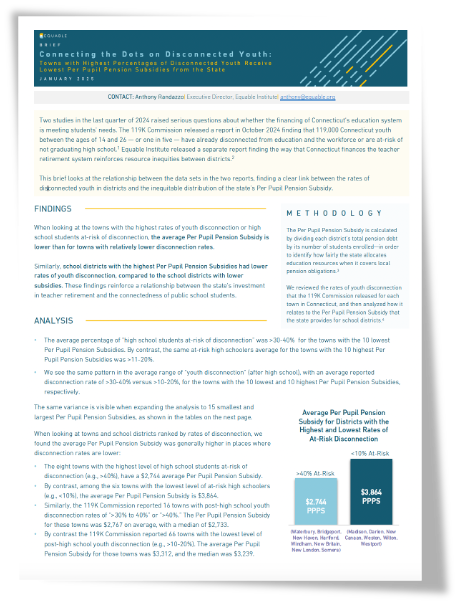Equable Institute has released a new brief showing a relationship between the state’s investment in teacher retirement and the percentage of disconnected youth in Connecticut public school districts. The brief compares data sets from two reports that were released in the last quarter of 2024: the first, a report from the 119K Commission that found 119,000 youth have already disconnected from education and the workforce or are at-risk of not graduating high school; and, the second, a report by Equable Institute that found Connecticut’s financing of the teacher retirement system reinforces resource inequities between school districts. The latter report uses a metric called the Per Pupil Pension Subsidy, dividing each district’s total pension debt by its number of students enrolled, to identify how fairly the state allocates education resources when it covers local pension obligations.
Today’s new brief finds that the average Per Pupil Pension Subsidy from the state is lower for towns with higher disconnection rates. In contrast, school districts with the highest Per Pupil Pension Subsidies had lower rates of youth disconnection.
“These findings show us that there is a relationship between teacher salary, teacher retirement benefits, and the connectedness that students feel in their school districts,” explained Anthony Randazzo, Executive Director of Equable Institute. “By subsidizing differences in compensation between districts, the state is reinforcing unequal educational opportunities between its towns. Contributions to the Teachers Retirement System are over a quarter of Connecticut’s annual K-12 education budget, meaning the state’s pension subsidy has a significant influence on students’ educational experiences and engagement.
“If the state were to require school districts to pay for a portion of retirement costs — such as by paying a portion of the normal cost — it could improve the competitiveness of lower resourced towns and reduce inequity in how K12 resources are distributed,” Randazzo added. “Depending on the exact formula adopted, the state’s required pension subsidy could be reduced by hundreds of millions, allowing for state leaders to use the budgetary savings on improvements to K12 funding generally, such as the needs identified by the 119K Commission’s report.”


